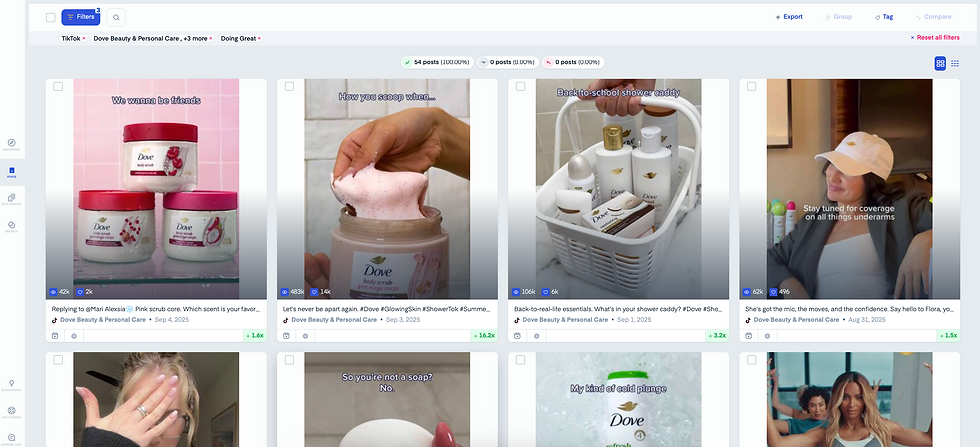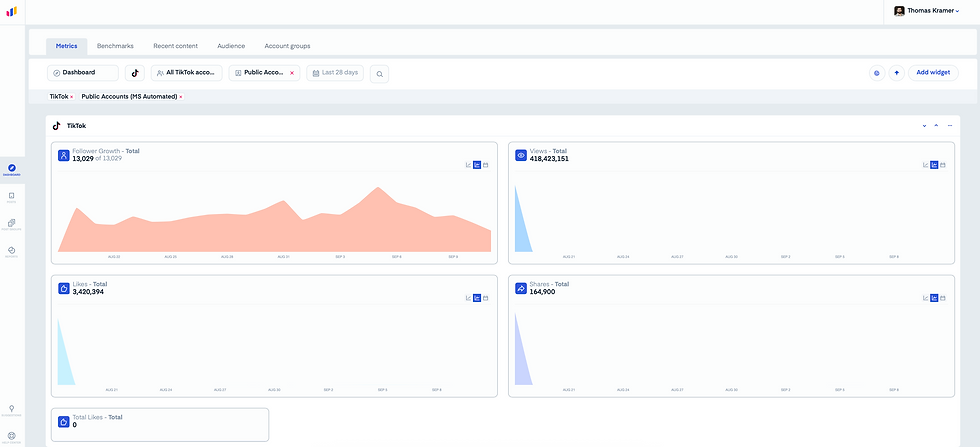How to Use TikTok Listening to Make Your Presence Viral-Worthy
- Sweta Panigrahi
- Sep 12
- 7 min read
You know the feeling. You've got your phone in hand, scrolling through TikTok, and boom, jump scare. Another creator with half your budget, zero fancy equipment, and a trending audio just hit a million views overnight. Meanwhile, your brand’s feed feels dead.
It’s not like you're slacking off. Your team stays on top of every challenge, every trending sound, every editing hack that the algorithm seems to reward. The content calendar is packed.
Videos are polished. Hashtags are researched. You have even convinced your CEO to awkwardly point at floating text bubbles.
And yet… nothing. No viral hits. No breakout post. Just a steady trickle of likes from coworkers and maybe a share or two from your most loyal customers.
Then comes the hard part: explaining it. In the next team meeting, leadership starts asking the dreaded questions: “Why aren’t we growing?” “Is TikTok even worth it for us?” Suddenly, it feels like your brand’s entire presence on the platform is on the chopping block.
The truth is, going viral on TikTok isn’t just about effort or jumping on every sound or dance the second it trends.
Brands pour hours into content, only to realize later that they have been guessing in the dark. And nothing’s worse than realizing all that sweat equity didn’t move the needle.
Because on TikTok, the difference between a post that dies in silence and one that blows up isn’t magic. It’s a signal. And most brands aren’t listening.
What is TikTok listening?
When we talk about TikTok listening, we are not accessing private or sensitive information. Everything comes from publicly available data on TikTok accounts you don’t own, competitors, creators, industry peers, or aspirational brands.
Here are the key types of data you can retrieve and analyze:
1. Content performance signals
Video views: how many times a video has been watched.
Likes: the number of hearts a video has received.
Shares: how often viewers are passing content along (a strong virality signal).
Total engagements: the combined number of likes and shares.
Performance trends over time: spotting consistent winners vs. one-off spikes.
2. Content mix & format data
Breakdown of content styles: original videos, duets, stitches, trending audio remixes.
Ratio of formats used (e.g., 80% original content vs. 20% duets/stitches).
Adoption of new TikTok features like carousel posts or TikTok Shop integrations.
3. Posting patterns
Frequency and volume of posts.
Timing of uploads (days, time of day).
Shifts in posting cadence, like ramping up around product drops or campaigns.
4. Topic & creative themes
Recurring hashtags, challenges, or content pillars.
Creative styles: educational, entertaining, aspirational, promotional.
Tone of voice and storytelling approaches.
Visual identity signals like editing style, text overlays, or popular meme formats.
5. Benchmarking opportunities
Top-performing vs. underperforming competitor videos.
Median engagement benchmarks by format, theme, or hashtag.
Comparative growth signals (e.g., sudden view surges or share spikes).
With Measure Studio, all of this public data is aggregated and aligned against your own TikTok metrics. That means you don't only see what others are doing, but also understand how your performance stacks up in context.
This helps you answer high-level strategic questions like:
Are we publishing enough relative to competitors?
Are our videos underperforming compared to the industry median?
Which themes consistently outperform in our niche, and are we covering them?
What content formats or trends aren’t competitors leveraging yet?
By leveraging public TikTok data at this depth, listening shifts to structured, competitive intelligence.
Why does TikTok listening matter?
TikTok isn’t like other platforms. Trends move at lightning speed, a sound that’s hot today is old news by the weekend. Challenges pop up out of nowhere, duets and stitches flip a narrative overnight, and suddenly a creator with zero followers is sitting on a million views.
For brands, that pace is brutal. You can spend weeks planning content, only to realize the trend is gone by the time you post. Or worse, you jump on the trend, but your video still flops while someone else’s blows up.
That’s where TikTok listening makes all the difference. You're not just watching your own numbers, you're tapping into competitor and creator data to see which formats, sounds, and themes are actually cutting through.
Here’s what that means for your brand:
Stay ahead of the curve: Spot rising audios and challenges before they peak, so you are first, not last, to the party.
See what resonates: Understand which types of videos are pulling real engagement (shares, not just likes).
Avoid wasted effort: Skip trends that look big but don’t deliver results in your category.
Find white space: Discover topics or formats competitors aren’t touching yet, and claim them as your own.
On TikTok, virality isn’t about pumping out more posts. It’s about creating content that fits the moment. Listening is how you see those moments coming.
How to use TikTok listening in Measure Studio
TikTok listening inside Measure Studio is powered by public data, meaning you don’t need login credentials to track competitor, creator, or influencer accounts.
Once you connect the profiles you want to monitor, the platform starts pulling in their video performance so you can analyze what’s really working across your niche.
Here’s how to put it to use:
1. Add competitor or creator accounts

Go to Manage Social Accounts, then Add Account and select the Public option. Drop in the TikTok profile URL. Measure Studio will sync the data (this can take up to 24 hours), and you’ll see their videos appear in your workspace.
2. Track video-level metrics

For every TikTok post, you’ll get:
Total Views – how many times the video has been watched
Total Likes – the audience’s quick engagement signal
Total Shares – the strongest indicator of virality and reach
Total Engagements – combined likes + shares to measure traction at a glance
(Note: Comment counts, Story metrics, and Live data aren’t available.)
3. Benchmark against competitors

Use competitor accounts as benchmarks to see how your content stacks up. Are your videos pulling similar engagement rates? Are they posting more often or at different times? This context helps you answer tough questions from your team with data.
4. Organize posts with Post Groups

Group competitor videos with your own to analyze trends side-by-side using Post Groups. For example:
Compare product demos across multiple brands
Study seasonal campaigns in your niche
Track what content themes (funny skits, tutorials, inspirational edits) drive consistent results
5. Spot category-wide trends with Account Groups

Create groups of competitor accounts to zoom out and see what’s working across an entire category. This is especially useful when you are tracking multiple players in your industry and want to uncover broader patterns.
6. Layer competitor insights into reports

Include TikTok public data in your scheduled or on-demand reports to share competitive insights with your team. Instead of just showing your performance, you can now show how you stack up against the wider landscape.
Bonus: Expert tips to get the most out of TikTok listening
It’s one thing to track competitor data. It’s another to actually turn those insights into a viral-worthy content engine.
Here are a few pro moves to squeeze maximum value from TikTok listening in Measure Studio:
Track flops as carefully as wins: Everyone studies the viral hits, but you’ll learn just as much from videos that don’t land. Look for patterns in competitor flops: Was it too long? Off-trend? Overly promotional? Avoid those same pitfalls in your own calendar.
Monitor sounds and audios, not just views: Virality on TikTok is often sound-driven. Keep an eye on which audio competitors are leaning into—and how early they jump. If you see multiple accounts testing a sound before it peaks, that’s your chance to move fast.
Watch share rates, not just likes: Likes are easy; shares are gold. When people hit “share,” it means the content has true viral pull. Prioritize insights from videos with unusually high share-to-like ratios.
Benchmark cadence, not just engagement: How often are your competitors posting? Daily? Multiple times per day? If your engagement looks solid but you’re only posting half as often, you may be leaving your reach on the table.
Group by content themes: Don’t just compare “brands vs. brands.” Break videos into themes like tutorials, challenges, duets, behind-the-scenes, and see which category consistently outperforms. This helps you build a smarter, more balanced mix.
Look for white space: The real opportunity isn’t always in copying trends. It’s in spotting what nobody else is doing yet. If you see competitors all chasing the same challenge but ignoring a rising topic or audience interest, that’s your moment to own it.
Wrapping up
TikTok is one of the most competitive and demanding platforms out there. Your brand can jump on every trending sound, test endless filters, and still struggle to break through the noise.
That’s exactly why many brands hesitate to fully commit to TikTok. But here’s the upside! Their hesitation creates an opening for you. While others pull back, you can step forward.
By using TikTok listening, you’re not just guessing what might work, you're learning directly from what’s already working (and failing) across your niche. That means every post you create is more strategic and better positioned to go viral.
With Measure Studio, you don’t just track your own performance, you gain full visibility into your competitors, industry leaders, and creators you admire. You’ll see where you stand, what to double down on, and where your brand can slay.
Ready to make TikTok work for you instead of against you? Start using Measure Studio today and turn listening into your competitive edge.
Frequently Asked Questions
What is TikTok listening?
TikTok listening is about tracking publicly available data from competitors, creators, and industry peers to understand what content lands, what flops, and where the opportunities are. It’s not about spying or stealing, it’s about spotting patterns and turning them into smarter moves for your brand.
How is TikTok listening different from just checking my own analytics?
Your analytics only show how your content performs. Useful? Totally. But it’s like looking at yourself in the mirror, you are only seeing part of the picture. TikTok listening zooms out. You get context on what’s working in your space overall, where your brand stacks up, and which trends or strategies you might be missing.
How does Measure Studio make TikTok listening easier?
Normally, competitor research on TikTok means endless scrolling, manual tracking, and messy screenshots. With Measure Studio, all that data is pulled in automatically. You can benchmark your posts, compare performance side by side, group content by themes, and even spot rising trends without drowning in spreadsheets.



This article perfectly captures how success on TikTok isn’t about luck — it’s about listening, analyzing, and responding strategically. The same principle applies to health and wellness: paying attention to your body’s signals can make all the difference in finding effective solutions. For example, if you’ve been dealing with chronic discomfort, exploring regenerative approaches like stem cell therapy might be worth your attention. You can learn more here https://ways2well.com/blog/stem-cells-for-neck-pain-what-you-need-to-know Just like data-driven marketing helps brands thrive, listening to your body helps you live better.
The Kolkata Fatafat is a completed number-based game. It looks simple, but it requires a particular state of mind. Sometimes, based on the day, players predict numbers for quick wins.
Basket Random is RHM Interactive's quirky 2-player basketball game in which physics and randomness dominate the floor. Each match contains a different location, humorous characters, and surprising ball movements.